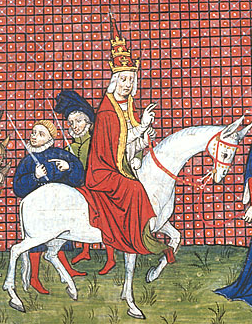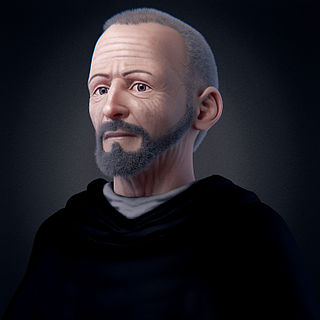
The Order of Preachers, commonly known as the Dominican Order, is a Catholic mendicant order of pontifical right that was founded in France by a Castilian priest named Dominic de Guzmán. It was approved by Pope Honorius III via the papal bull Religiosam vitam on 22 December 1216. Members of the order, who are referred to as Dominicans, generally display the letters OP after their names, standing for Ordinis Praedicatorum, meaning 'of the Order of Preachers'. Membership in the order includes friars, nuns, active sisters, and lay or secular Dominicans. More recently, there have been a growing number of associates of the religious sisters who are unrelated to the tertiaries.

Pope Gregory XI was head of the Catholic Church from 30 December 1370 to his death, in March 1378. He was the seventh and last Avignon pope and the most recent French pope recognized by the modern Catholic Church. In 1377, Gregory XI returned the Papal court to Rome, ending nearly 70 years of papal residency in Avignon, in modern-day France. His death was swiftly followed by the Western Schism involving two Avignon-based antipopes.

Santa Maria sopra Minerva is one of the major churches of the Order of Preachers in Rome, Italy. The church's name derives from the fact that the first Christian church structure on the site was built directly over the ruins or foundations of a temple dedicated to the Egyptian goddess Isis, which had been erroneously ascribed to the Greco-Roman goddess Minerva.

Vincent Ferrer, OP was a Valencian Dominican friar and preacher, who gained acclaim as a missionary and a logician. He is honored as a saint of the Catholic Church and other churches of Catholic traditions.

Angelus of Jerusalem, OCarm was a Catholic convert from Judaism and a religious priest of the Carmelites of the Ancient Observance.

Benedict the Moor was a Sicilian Franciscan friar. Born of enslaved Africans in San Fratello, he was freed at birth and became known for his charity.

The Third Order of Saint Dominic, also referred to as the Lay Fraternities of Saint Dominic or Lay Dominicans since 1972, is a Catholic third order which is part of the Dominican Order.

Giovanni Dominici, OP was an Italian Catholic prelate and Dominican who became a cardinal. His ideas had a profound influence on the art of Fra Angelico, who entered the Dominicans through him.

Raymond of Capua, was a leading member of the Dominican Order and served as its Master General from 1380 until his death. First as Prior Provincial of Lombardy and then as Master General of the Order, Raymond undertook the restoration of Dominican religious life. For his success in this endeavor, he is referred to as its "second founder".

John Macías, OP, was a Spanish-born Dominican friar who evangelized in Peru in 1620. He was canonized in 1975 by Pope Paul VI. His image is located at the main altar of the Basilica of Our Lady of the Rosary of Lima and is venerated by the local laity in Peru. A church was built in his honor in 1970 in San Luis, Lima.

École biblique et archéologique française de Jérusalem, commonly known as École Biblique, is a French academic establishment in Jerusalem specializing in archaeology and Biblical exegesis. It is housed by the Saint-Étienne priory. Associated with the Order of Preachers (Dominicans), it is one of two major Roman Catholic biblical academies in Jerusalem, along with the Studium Biblicum Franciscanum.

The Dominican Order was first established in the United States by Edward Fenwick in the early 19th century. The first Dominican institution in the United States was the Province of Saint Joseph, which was established in 1805. Additionally, there have been numerous institutes of Dominican Sisters and Nuns.

Blackfriars Leicester, also known as St Clement's Church, Leicester and St Clement's Priory, Leicester, is a former priory of the Order of Preachers in the city of Leicester in Leicestershire, England. It is also the name of a former civic parish, and a neighbourhood in the city built on and around the site of the old priory.

Antonio Patrizi was an Italian Roman Catholic priest and a professed member of the Order of Saint Augustine. Patrizi joined the order in Lecceto and lived as a hermit prior to his sudden death while visiting his friend at another convent.

Giacomo Bianconi was an Italian Roman Catholic priest and a professed member of the Order of Preachers. Bianconi - who hailed from Umbria - joined the order in his adolescence and dedicated his pastoral career to his flock and on one notable occasion aided refugees when Frederick II sacked the area in 1248. He also combatted heresies and managed to convert one of their chief propagators while also distinguishing himself through his life of extreme poorness that went past the Dominican standards.

Pedro Vásquez, O.P, also known as Peter Vásquez, was a Spanish Dominican friar, Catholic priest, and missionary who died a martyr in Japan. He was beatified in July 1867 by Pope Pius IX.
Antonio Piccolomini, O.S.B. was a Roman Catholic prelate who served as Archbishop of Siena (1459) and Bishop of Siena (1458–1459).

Gabriel Ferretti was an Italian Roman Catholic priest and a professed member of the Order of Friars Minor. He was an ancestor to both Cardinal Gabriele Ferretti and Pope Pius IX having been descended from a long noble lineage. Ferretti entered the religious life after becoming of age and soon after his ordination held two important leadership positions in the order. He set about restoring run down Franciscan convents in the region as well as seeing to the establishment of new ones to deal with an influx of new novices.
Procter, Lives of the Dominican Saints, pp. 210-213. (See further V. Pellazza, Elogio storico del B. Antonio (1863) Taurisano, Catalogus Hagiographicus O.P., p. 40; and L. Ferretti, Vita del B. Antonio (1919))

















